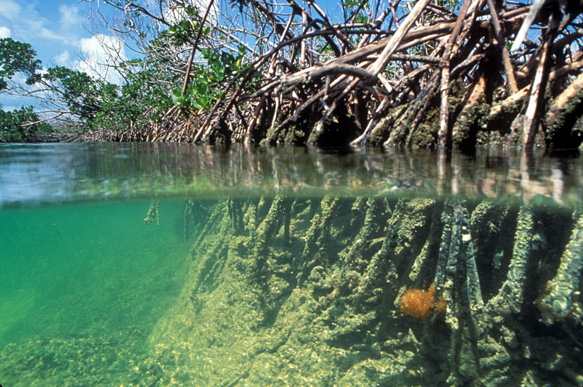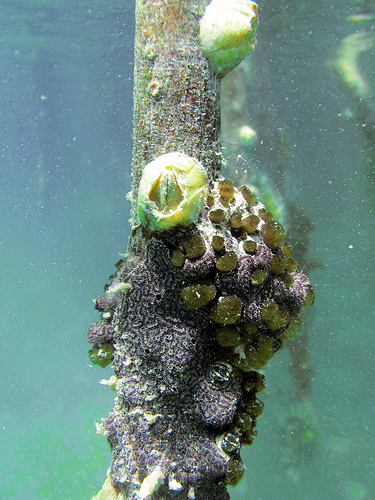If there's barnacles, hydroids, sponges and mangrove roots there must be...Tunicates!
 As the name implies, mangrove tunicates make marine mangrove
environments their home. Mangroves are groupings of trees in
intertidal zones occurring between land and sea. Many organisms
call the mangroves home both above and below the surface of the
water. Several bird species find shelter among the branches and
there are crabs that feed upon the leaves. Below the surface
there is a plethora of marine life. The mangrove environment is
subject to many changes as pollution can alter the salt and
chemical levels. The roots of the mangrove trees enter the water
and become the target for many organisms including the mangrove
tunicates. Corals, tunicates, barnacles,
sponges, and hydroids inhabit these roots.
As the name implies, mangrove tunicates make marine mangrove
environments their home. Mangroves are groupings of trees in
intertidal zones occurring between land and sea. Many organisms
call the mangroves home both above and below the surface of the
water. Several bird species find shelter among the branches and
there are crabs that feed upon the leaves. Below the surface
there is a plethora of marine life. The mangrove environment is
subject to many changes as pollution can alter the salt and
chemical levels. The roots of the mangrove trees enter the water
and become the target for many organisms including the mangrove
tunicates. Corals, tunicates, barnacles,
sponges, and hydroids inhabit these roots.
 In
particular mangrove tunicates and sponges prefer prop roots.
Prop roots are those that have yet to enter the marine sediment.
Sponges use this particular technique because they are
echinoderms, such as
star fish can feed on the sponges if the root has reached
the sediment. The roots are chosen because they are a hard
substrate, suitable for attachment.
In
particular mangrove tunicates and sponges prefer prop roots.
Prop roots are those that have yet to enter the marine sediment.
Sponges use this particular technique because they are
echinoderms, such as
star fish can feed on the sponges if the root has reached
the sediment. The roots are chosen because they are a hard
substrate, suitable for attachment.
In particular, Ecteinascidia turbinata are located in tropical mangroves located around the Florida keys, Bermuda, and the Bahamas. Mangrove tunicates are also known to grow in the intertidal zones around India.
Let the knowledge flow by checking out adaptations of E. turbinata.